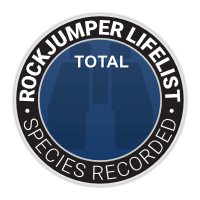Image of the Month March 2017: Crested Berrypecker
PREVIOUS PAGE
The world’s largest tropical island, New Guinea, stands apart, ranking atop the most fascinating and exotic places on the planet. The last inhabited landmass to be explored by Europeans, it remains overrun with birds. Most famous for its spectacular birds-of-paradise, it sports seven endemic bird families too. These include the Satinbirds, three monotypic families (Wattled Ploughbill, Blue-capped Ifrit, and Mottled Berryhunter), and also the painted berrypeckers, including the Crested Berrypecker, pictured here.
The namesake crest can be flattened out (as above), or raised when agitated or in display. Unlike its only close relative, the Tit Berrypecker, Crested is not sexually dimorphic, but both species exhibit filoplumes (filament-like feathers, seldom visible in the field) along the flanks. The function of these remains a mystery. Crested also differs from Tit Berrypecker in that it varies tremendously in size: weighing from 36 – 61 grams, largely depending upon altitude. Studies show their range is climbing upslope, a grim reminder of the reality of climate change.
In addition to harboring these birds, plus a bevy of showy kingfishers, parrots and pigeons, New Guinea anchors several bioregions. Considered by some to be the easternmost island of the Malay Archipelago, it is the westernmost point of Melanesia, and the northernmost of Australasia. Though it exhibits characteristics of each, it is unique beyond them all. Its uniqueness begins with its isolated location, combined with its geography and sheer size – setting aside continental Australia, the only larger island is Greenland. Rich with humid forest, New Guinea features the highest mountains in Oceania, so perhaps it is little wonder that it is home to so many unique and dazzling birds.
Birds are an undeniable feature of the island, both among visitors and natives. The spectacular Birds-of-paradise cannot go unseen. From their absurdly gaudy appearance to their sounds and impossible displays, they demand our rapt attention. Their extraordinary plumes have long highlighted the apparel of native peoples and foreigners too. With relatively few mammals or other sources of protein present, natives have a tradition of hunting birds, the result being a profound respect for birds, along the lines of kin. Indeed, birds are integral to New Guinea, from its culture today to its history and even within its geography, the island itself is described as looking like a bird. The west end features the Bird’s Head Peninsula, while the east end’s Bird’s Tail Peninsula gives way to Melanesia.
Exotic, isolated, tropical and brimming with spectacular birds, parts of New Guinea remain today much as they did centuries ago. You can see many of these fantastic birds, including Crested Berrypecker, on one of the following upcoming tours:
Papua New Guinea – Birding in Paradise V 25 Jul – 11 Aug 2017 (18 days)
Tour Price: PGK26,250 USD8,256* GBP6,642* EUR7,792*
Spaces available
Papua New Guinea – Highlights 04 – 13 Sep 2017 (10 days)
Tour Price: PGK16,500 USD5,189* GBP4,175* EUR4,898*
Spaces available
Alternatively, the following trips on the north-west side of the Malay Archipelago promise not to disappoint, with a fantastic array of Indonesian endemics and other specials:
Indonesia – Sulawesi & Halmahera – Wallacean Endemics 09 – 22 Sep 2017 (14 days)
Tour Price: IDR62,000,000 USD4,622* GBP3,722* EUR4,313*
Spaces until viable: 1
Indonesia – Highlights of the East: Sulawesi, the Moluccas & Papua 23 Aug – 07 Sep 2017 (16 days)
Tour Price: USD6,750 GBP5,449* EUR6,278*
Spaces until viable: 2
* Alternate currencies are for comparative purposes only
